- Home
- Richard Matheson
Mediums Rare
Mediums Rare Read online
Mediums Rare
Richard Matheson
Copyright
Mediums Rare
Copyright © 2000 by Richard Matheson
Cover art to the electronic edition copyright © 2011 by RosettaBooks, LLC
All rights reserved. This book, or parts thereof, may not be reproduced in any form without permission in writing from the publisher or the author.
This book is a work of fiction. Names, characters, places and incidents are either the products of the author’s imagination or are used fictitiously.
Electronic edition published 2011 by RosettaBooks LLC, New York.
ISBN e-Pub edition: 9780795316944
To my good friend
Stephen Simon
with gratitude and affection
and great admiration for the
spiritual path he has chosen to take
Medium: An intermediate agency, means, instrument or channel.
–The Oxford Universal Dictionary
Contents
e-Introduction
Some Early Beginnings
The Fox Sisters
Afterward
Interim
Nettie Colburn
Afterward
D.D. Home
Afterward
Growth
Eusapia Palladino
Afterward
Body To Mind
Mrs. Piper and Mrs. Leonard
Afterward
Frauds
Margery
Afterward
Medium Most Rare
Edgar Cayce
Afterward
The New Approach
Conclusion
Afterword
Bibliography
e-Introduction
This book contains a brief account of psychic beginnings.
Parapsychology, today, utilizes a highly advanced methodology.
It has, long since, left behind the era of dim-lit parlors and spiritual melodramatics.
It is, now, a completely legitimate field of study based upon precise and sophisticated test procedures.
It began quite differently.
And now ends up as an E-Book.
Metaphysics has always interested me. It inspired me to write: What Dreams May Come, The Link, Come Fygures Come Shadowes, The Path, and various short stories. It inspired me to compile the historical accounts in this book. I hope it will inspire some of you.
Some Early Beginnings
The story about King Croesus of Lydia—somewhere around five forty-six b.c.—is a famous account of the paranormal in ancient times.
As the story goes, King Croesus wanted to declare war on one of his neighboring countries.
He wasn’t sure though if he could win or not so he sent envoys to seven of the greatest oracles in the region and had them ask the same question in all seven countries.
“What is King Croesus doing today?” (“Today,” being the hundredth day after each envoy had departed from the King.) Five of the oracles got it wrong. The sixth was close. Only the seventh got it right. He spoke about smelling a tortoise and a lamb cooking in a brass cauldron.
Which was exactly what Croesus was doing that day.
Satisfied, King Croesus asked the seventh oracle what would happen if he invaded the neighboring country.
The oracle told him that he saw the defeat of a great army.
Croesus liked the sound of that and invaded. He should have asked the oracle which army he was talking about.
As it turned out, it was Lydia’s.
There is good recorded information about a nun named St. Teresa of Avila.
A Sister Anne of the Incarnation at Segovia gave a deposition under oath in which she described how St. Teresa, after kneeling for about fifteen minutes, was raised up in the air more than two feet. Remaining suspended there for something like a half hour.
Emanuel Swedenborg was a Swedish mystic and philosopher of the seventeenth century.
In his earlier years he was a great inventor, designing devices such as a submarine, a flying machine and an air gun that could fire up to seventy rounds without re-loading.
He also wrote important works on astronomy, anatomy, geology and other sciences.
He was, in addition, psychic.
In his later years, religion became his chief pre-occupation.
His most famous book is the Arcana Coelestia which he believed he’d received in its entirety from the spirit world.
There is an interesting story having to do with Swedenborg and the widow of the Dutch ambassador in Stockholm.
A goldsmith came to see her some time after her husband had died and asked to be paid for a silver service her husband had bought from him.
The wife was sure her husband had already paid the bill but couldn’t prove it.
As the amount was considerable, she asked Swedenborg for his help.
He came to her house three days after her request and told her that he’d had a conversation with her late husband.
He said that the bill had been paid and that the receipt for it was in a certain bureau in an upstairs room.
The widow was embarrassed by this because she knew that the bureau had been entirely cleaned out.
Swedenborg told her that the top left hand drawer of the bureau should be removed to reveal a board which, when drawn out, would reveal a secret compartment and the missing receipt as well as some letters.
They went upstairs and found the compartment exactly as Swedenborg had described it. The receipt was there. So were the letters.
Swedenborg also described a fire in Stockholm when he was in Gothenburg, three hundred miles away.
He told a group of fifteen people how a house that belonged to a friend of his was in ashes and that his own house was in danger. About four hours later, he told the group that the fire was out, extinguished only three doors from his house.
This all took place on a Saturday afternoon.
On Sunday, Swedenborg described the fire to the local governor—how it began, how long it had burned and how it had been put out.
On Monday evening, a messenger arrived from Stockholm.
The letters he carried described the fire exactly as Swedenborg had on the previous Saturday and Sunday.
A few years after the philosopher Immanuel Kant had described Swedenborg’s clairvoyant powers—(the power to see at a distance), the first official inquiry into paranormal phenomena was conducted in France.
It was designed specifically to investigate the claims of one Anton Mesmer, an Austrian doctor who claimed that he was healing people with a force he called ‘animal magnetism.’ (Later to be called ‘Mesmerism.’)
Mesmer’s consulting rooms were illuminated most mysteriously, hung with mirrors, heavily perfumed. Soft music played while Mesmer wandered around among his patients, dressed in a violet robe and carrying an iron wand.
The main feature of the room was an apparatus called a baquet, a circular wooden tub filled with water, iron filings and what Mesmer chose to call ‘magnetized’ water.
Patients sat around the tub, linked together with wet ropes. Iron rods—Mesmer called them ‘conductors’—extended from the tub and were placed in contact with the affected parts of each patient.
Up to thirty rods were utilized simultaneously, creating a mild electric current since the tub was like a Leyden jar, a forerunner of the battery.
Mesmer and his assistants would stroke the patients and make strange, ritual-like hand movements over them and Mesmer would touch them with his iron wand.
This, added to the electrical stimulation, would cause the patients to get excited and, usually, end up having convulsions.
Naturally, having that many patients together at one time contributed to a kind of contagi
ous hysteria.
It was no wonder, then, that so many of these people were convinced that they were healed.
Mesmerism also resulted in sleep-like states during which patients demonstrated an ability at paranormal self-diagnosis and, on more than one occasion, telepathy, clairvoyance and prediction.
In the eighteen forties, a surgeon named James Braid experimented with Mesmerism and coined the word ‘neuro-hypnosis’ which was later shortened to ‘hypnosis.’
While not exactly an account of mediumship, it is interesting to note that many of the founders of the United States government were Masons. It has even been suggested that they received aid from some secret organization in Europe which helped to establish the United States for some specific purpose known only to an initiate few.
At any rate, the Great Seal of the United States is the signature of this organization and the unfinished pyramid with the All-Seeing Eye hovering over it, on the other side of the bill, is a symbol of the task to which the United States government was dedicated.
Analysis of the Great Seal reveals a mass of occult and Masonic symbols. The eagle was, as a matter of fact, a phoenix on the original design, with the Great Pyramid of Gizeh on the reverse side. On a colored sketch submitted by William Barton in 1783, an actual phoenix appears sitting on a nest of flames, a symbol of the new rising from the old.
Later, both of these illustrations were altered to what they are today. Benjamin Franklin thought the eagle was unworthy to be chosen as the emblem of a great, progressive nation, saying that it “was not even a bird of good moral character.” He suggested the turkey.
The significance of the mystical number thirteen is not limited to the number of the original colonies either. It appears frequently on the Great Seal as well. For instance, the sacred emblem which appears above the head of the eagle contains thirteen stars. The motto E. Pluribus Unum contains thirteen letters. So, too, does the description Annuit Coeptis on the reverse side of the bill. The eagle clutches, in its right talon, a branch bearing thirteen leaves and thirteen berries. And, in its left talon, it carries a sheaf of thirteen arrows. An interesting side-note to this is the fact that the head of the eagle faces away from the arrow of war, toward the branch of peace.
Then too, the face of the now unfinished pyramid, exclusive of the bottom panel with the date on it, consists of seventy-two stones arranged in thirteen rows.
Returning to mediumsbip.
It is generally accepted that the birth of Spiritualism (which was, in time, the origin of modern Parapsychology) took place in the home of Mr. and Mrs. John D. Fox in the year 1848.
The Fox Sisters
March 31, 1848
Hydesville, New York
Since they’d moved into the house the previous December, noises had been bothering them.
The farm house was a small one, consisting of a single floor with several rooms, a cellar underneath it and a loft above.
Rappings and sounds like that of moving furniture had been heard time and again.
John David Fox and his wife had lit candles and moved around the house, searching every room.
They’d never discovered a source of the noises.
This night, they were worse than they had ever been, occurring in all parts of the house.
The couple even thought they heard footsteps in the pantry and Margaret Fox was sick with fear, convinced that some unhappy spirit haunted the house.
It had snowed that day and an icy wind was scouring the house. John Fox kept checking the sashes on the windows, thinking that they might be rattling to cause the sounds.
But the noises were taking place everywhere and both he and his wife were frightened for their two daughters, Margaret, ten, and Kate, seven; the two girls slept in the same room with them.
In an attempt to rationalize the fear they were experiencing, the girls had begun to attribute the noises to some mysterious, invisible entity named Mr. Splitfoot.
Their parents weren’t happy with this fancy but allowed it to persist since it seemed to ameliorate the girls’ reaction to the noises. And there was certainly no way they could afford to leave the house.
They would all have to make the best of this disturbing situation.
Mr. Fox had not yet retired that night; it wasn’t even seven o’clock. His wife lay awake in bed, her daughters lying equally awake in their adjoining bed.
The loud, rapping noises were almost constant now, sounding from every quarter of the house.
Once the beds both jarred, making Mrs. Fox and their daughters gasp in shock.
Abruptly, Kate, her body locked with dread, cried out impulsively, “Mr. Splitfoot, do as I do!” and suddenly began to clap her hands.
The noises seemed to imitate and follow her until she stopped.
A heavy silence fell, mother and daughters wide-eyed, heart beats thumping.
Then Margaret cried out brazenly, “No, do just as I do!” and clapped her hands four times, calling, “Count one, two, three, four!”
Four rapping sounds immediately followed.
The younger Margaret shivered, pulling up the covers to her chin, her face gone pale.
What had she done?
She caught her breath, glancing sharply at her younger sister as Kate spoke, saying, “Mother, I know what it is. Tomorrow is April-fool day and it’s somebody trying to fool us.”
Mrs. Fox felt otherwise, convinced that someone haunted their house.
Her voice trembled while she asked, as proof, for the spirit to rap out the ages of her children.
Ten distinct rap sounds in the small room. Silence for a moment or two. Then seven raps. Kate whimpered, “Oh.”
Silence. Then three more raps were heard. Mrs. Fox sobbed frightenedly.
There’d been another daughter who had died at the age of three.
“Is this a human being who answers my questions so correctly?” she asked in a feeble voice.
Silence. Her two girls clung to one another.
Mrs. Fox’s throat moved as she swallowed with difficulty. “Is it a spirit?” she asked. “If it is, make two raps.”
Two rapping noises sounded instantly, causing them to cry out.
Mr. Fox was in the same room now, listening, his expression tense.
“If it’s an injured spirit, make two raps,” said his wife.
The two raps were so loud, the house trembled from the impact. “Dear God,” whispered John Fox.
Then he cried out, “Will you continue to rap if I call in my neighbors so they can hear it too?!”
Again, the house shook with the violence of the answering raps.
At half past seven, Mr. Fox brought back their nearest neighbor, Mrs. Redfield.
Having heard his rambling account of what had happened, Mrs. Redfield was prepared to laugh, thinking it a joke.
But the moment she saw Dr. Fox and the two girls in their beds, pale with fright, she realized that something serious was happening.
“Ask it who it is,” Mrs. Fox told her. She had already done so and wanted to find out if Mrs. Redfield got the same answers she did.
Mrs. Redfield began to do this, asking one rap for yes and two for no.
By this gradual method, she discovered that the spirit was that of a man aged thirty-one, a peddler who had been murdered in this house, his remains buried in the cellar.
It was precisely what Mrs. Fox had been told by the rapping noises.
Mrs. Redfield then went out and got Mr. Fuesler and his wife who, in turn, got Mr. and Mrs. Hyde and Mr. and Mrs. Jewell.
All of them asked the same questions using one rap for yes and two for no.
The answers remained the same. A man. Thirty-one. Peddler. Murdered. Remains buried in the cellar.
The questioning continued through the night, long after the two girls had fallen asleep from exhaustion.
The story grew more bizarrely complicated by the hour.
The murder was committed in the east bedroom five years earlier.
The victim had had his throat cut with a butcher knife after which his body had been dragged through the pantry and down the stairway to the cellar where it was buried ten feet under the ground.
The murder had been committed to get the man’s money. Five hundred dollars in all.
They started digging in the cellar the next night but soon had to give up because they came to water. They could not resume until summer.
Then, at a depth of five feet, they found a wooden plank. Beneath the plank was charcoal and lime, hair and bones.
Doctors pronounced them to be the remains of a human skeleton.
Soon afterward, the phenomena assumed the character of a full-fledged haunting.
The sound of a death struggle was heard. A hideous throat gurgling, then dragging of a body across the floor of the house.
The sound of digging in the cellar.
Mrs. Fox’s hair began to turn white and, at last, the family had to leave the house.
The raps continued after they were gone.
One night, more than three hundred people conversed with the invisible entity.
Kate was sent to the house of an older brother, Margaret to the house of her older sister.
The phenomena continued in both places.
It was especially severe where Margaret was.
Her older sister was exposed to the first recorded “poltergeist” episode in the United States, objects hurled at her, pins stuck into her as she prayed, her cap and combs jerked roughly from her head.
One night, a visiting friend attempted to converse with the rambunctious spirit and, with deafening raps, a message was spelled out: “Dear friends, you must proclaim this truth to the world. This is the dawning of a new era. You must not try to conceal it any longer.”
AFTERWARD
Margaret Fox recanted in her later years.
She claimed that she and her sister Kate had produced the rappings by cracking their toe joints.

 Earthbound
Earthbound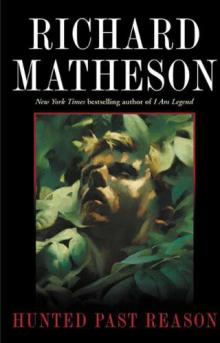 Hunted Past Reason
Hunted Past Reason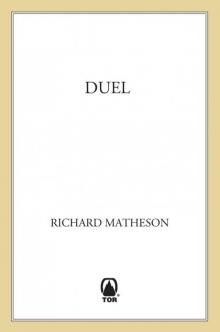 Duel: Terror Stories
Duel: Terror Stories 7 Steps to Midnight
7 Steps to Midnight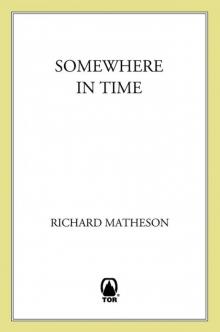 Somewhere in Time
Somewhere in Time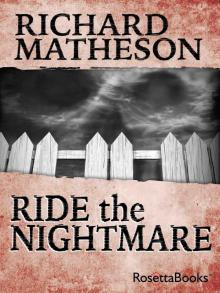 Ride the Nightmare
Ride the Nightmare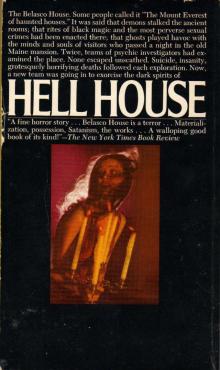 Hell House
Hell House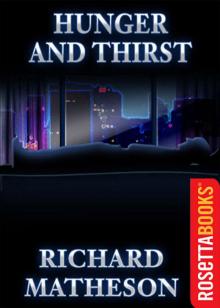 Hunger and Thirst
Hunger and Thirst Lyrics
Lyrics Other Kingdoms
Other Kingdoms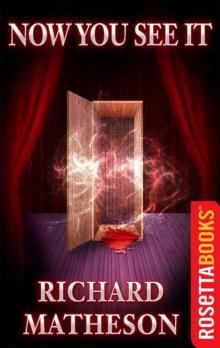 Now You See It . . .
Now You See It . . .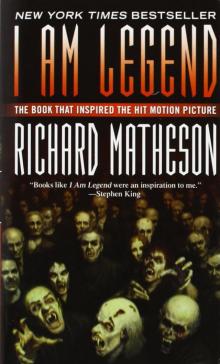 I Am Legend
I Am Legend The Box: Uncanny Stories
The Box: Uncanny Stories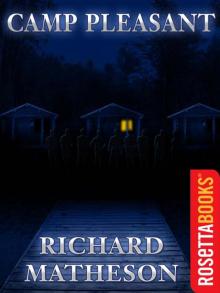 Camp Pleasant
Camp Pleasant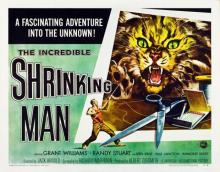 The Incredible Shrinking Man
The Incredible Shrinking Man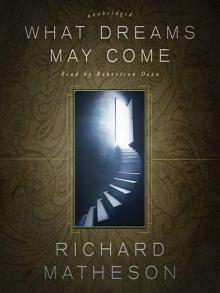 What Dreams May Come
What Dreams May Come The Gun Fight
The Gun Fight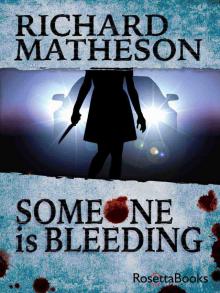 Someone Is Bleeding
Someone Is Bleeding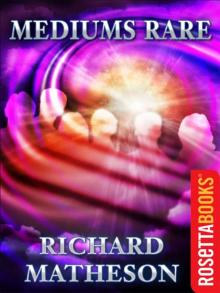 Mediums Rare
Mediums Rare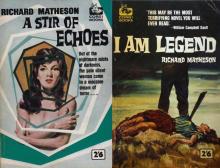 A Stir of Echoes
A Stir of Echoes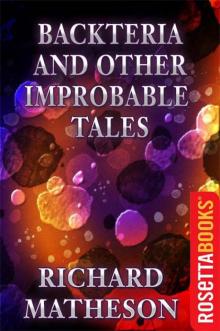 Backteria and Other Improbable Tales
Backteria and Other Improbable Tales Offbeat: Uncollected Stories
Offbeat: Uncollected Stories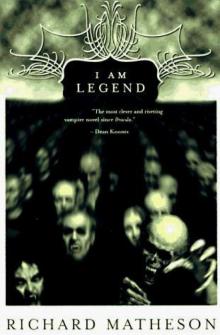 I Am Legend and Other Stories
I Am Legend and Other Stories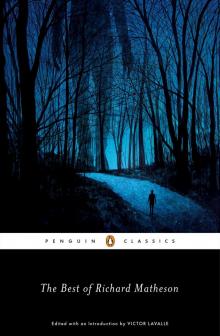 The Best of Richard Matheson
The Best of Richard Matheson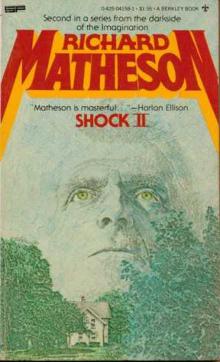 Shock II
Shock II Steel: And Other Stories
Steel: And Other Stories Richard Matheson Suspense Novels
Richard Matheson Suspense Novels The Link
The Link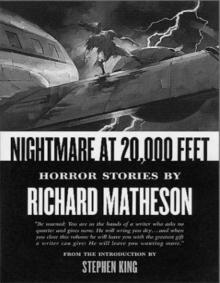 Nightmare At 20,000 Feet
Nightmare At 20,000 Feet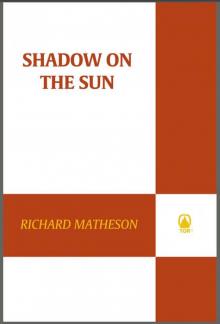 Shadow on the Sun
Shadow on the Sun![Steel and other stories [SSC] Read online](http://i1.bookreadfree.com/i/03/21/steel_and_other_stories_ssc_preview.jpg) Steel and other stories [SSC]
Steel and other stories [SSC]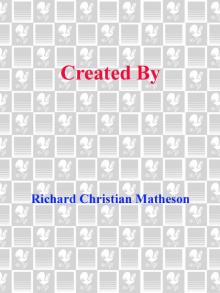 Created By
Created By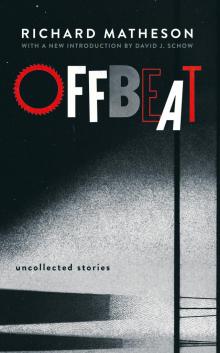 Offbeat
Offbeat Duel
Duel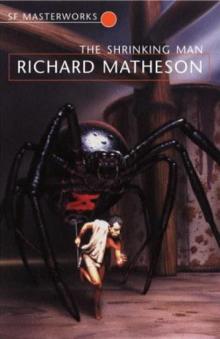 The Shrinking Man
The Shrinking Man Steel
Steel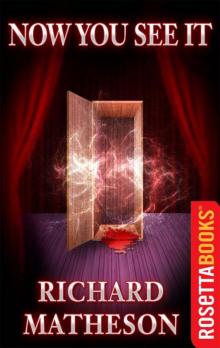 Now You See It
Now You See It